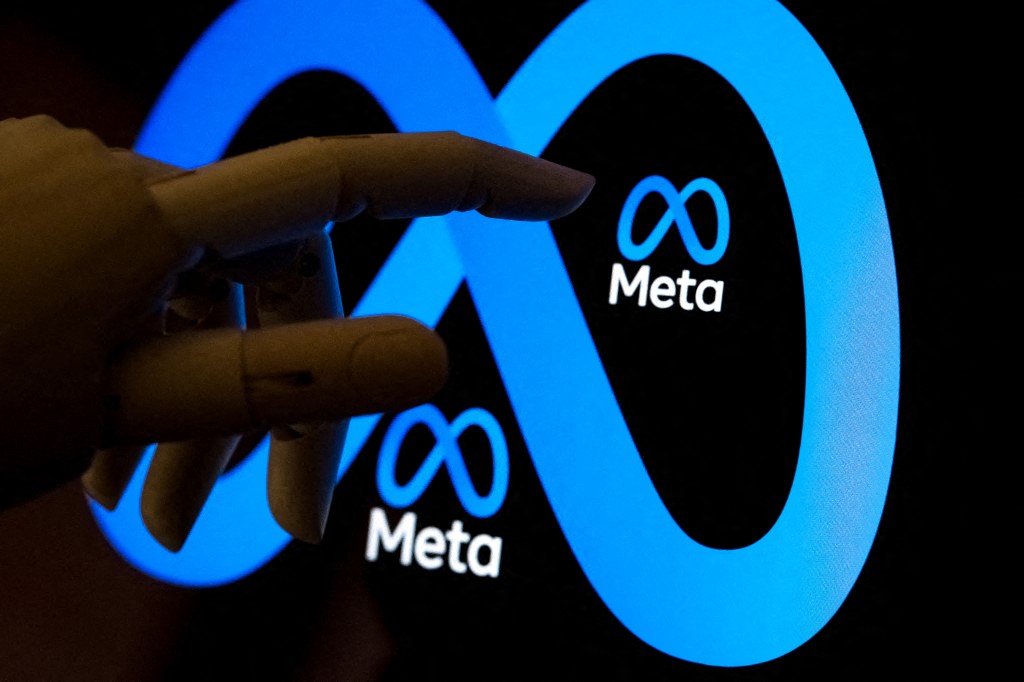Data and analytics company, Tatari, conducted surveys with advertisers to understand the future of TV and digital video investment. The impact of the pandemic has created seismic shifts in the spend strategy of various brands. These shifts have provided unparalleled opportunities for performance brands to test and refine new data-driven strategies in TV. It's also spurred by a need to reach new audiences beyond social platforms,
DTC brands have been at the forefront of this great experiment. The results of their efforts have begun to dispel enduring myths about the cost, precision and measurability of the channel, forging a path for TV to take its place alongside digital video as part of a disciplined omnichannel performance strategy.
The state of video ad spend
For marketers, video ad spend has grown beyond the usual suspects of social platforms — from Instagram to YouTube and programmatic web video. While these formats have their place in the video ecosystem, TV offers new opportunities for these brands to reach customers beyond digital channels. Make no mistake, TV still has some inherent advantages such as -massive reach, minimal ad fraud (as compared to online video on open exchanges) and viewing behaviors that lend more time and attention to brand messaging.
Watching TV is often an experience that spans an hour or more and ads occupy a part of that viewing experience and command the attention of the viewers. When it comes to video, whether it's pre-roll, mid-roll, banner or inapp video ads, they tend to cater to different attention spans, appearing on a much smaller screen for less time — and they often offer a choice to watch or skip.
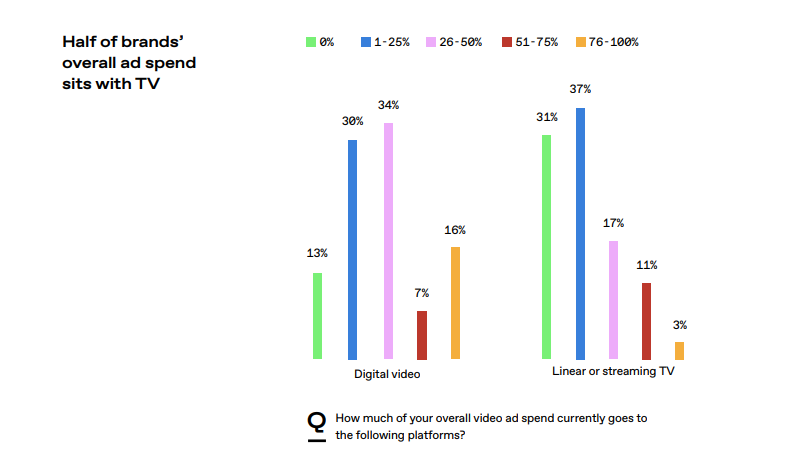
Advertisers in these two spaces are marked by differences in size. When we look at the size of companies identifying as larger brands — categorized as having 500-plus staff — they favor living-room video; CTV and linear TV is a significant factor in their ad spend. For smaller brands, standard digital video, i.e., desktop and mobile, still dominates. According to the survey results, 85% of brands stated that up to half their overall ad spend sits with linear or streaming TV and 77% of brands state the same for digital video.
Targeting and attribution perceptions
When it comes to targeting and attribution, video advertisers have grown more accustomed to standard digital video than to linear TV. The research shows that, across industries, advertisers believe they can achieve more precision in targeting by turning to standard digital video — with some differences between linear and streaming.

20% of respondents state that digital video is “very precise” compared to three percent who say the same about linear TV and six percent who say so about streaming. Advertisers commonly believe attribution and performance measurement are swifter on standard digital video, enabling faster campaign optimization — but experts in the DTC space have had a different experience.
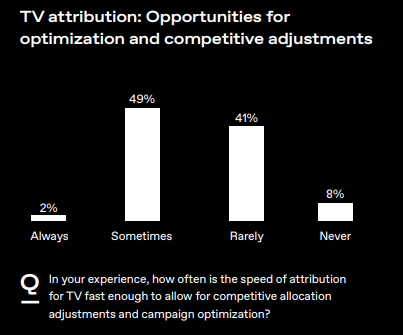
49% of respondents feel that TV is close to becoming fast enough to allow for competitive allocation adjustments and campaign optimization, and two percent believe it’s there already. Uncertainty may be keeping advertisers off of TV in an era in which COVID has created a need to react quickly. For some brands, it’s about setting goals that help marketers understand when and how to optimize.
How do advertisers rank metrics for attribution?
What’s valued most when it comes to accurately measuring attribution changes in digital versus traditional channels? Respondents say that impressions carry more importance for linear TV than digital metrics such as view through or cost per visitor/install/ acquisition. This switch of ranking shows that linear TV is still not as fully associated with digital metrics, despite TV becoming more digital. Streaming, which is pure digital, is more closely associated with digital metrics.
In essence, digital video advertisers want to measure a direct line to ROI from a user encountering their video ad, while linear TV is still focused on the brand awareness play for on-air advertisement. Indeed, the perceived barriers to TV are coming down. Attribution and targeting have now become faster on TV, allowing advertisers to optimize more flexibly and quickly, with the ability to adjust and refine on a weekly basis.
DTC brands are having second thoughts on TV
As advertisers continue to improve their understanding of targeting, attribution and speed to market transform, other challenges are entering a new light as well. Historically, TV has been the province of larger brands, and much of that has had to do with cost. While TV delivers a different experience to digital video, many DTC brands still worry about TV pricing — though with better measurement and greater transparency, brands are learning that even the highest prices are consistent with their disciplined KPIs for ROAS and CPA/CPV.
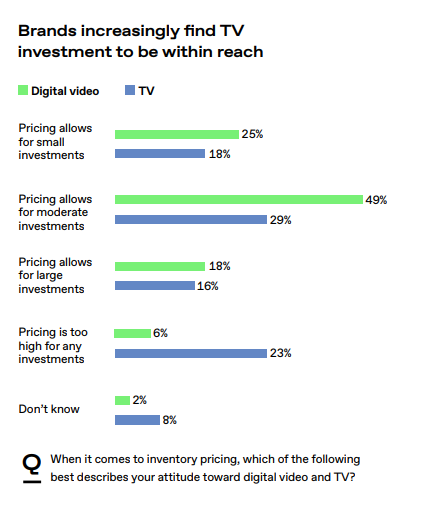
For smaller brands, pricing has historically been a major factor in TV-related decision-making but almost two-thirds (63%) of respondents have realized that TV does allow for investment. Furthermore, 44% of brands have increased this investment level as pricing shifted during the pandemic.
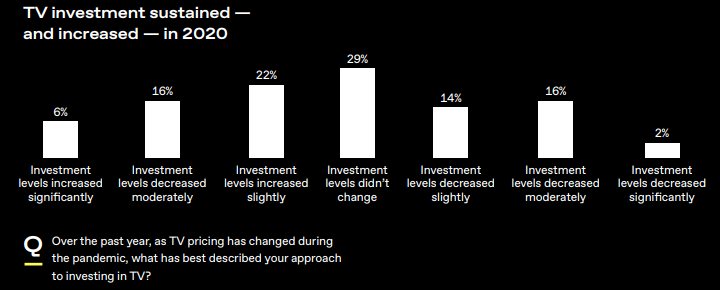
However, while TV pricing has been prohibitive for growth-stage brands, that factor has changed as larger advertisers pulled spend earlier in 2020, creating available inventory at a more affordable price.
Brands that increase TV investment reap the rewards
As the TV landscape changes, DTC brands have a major opportunity to increase exposure by investing in TV — and they can now afford it. Some already realize this, but some don’t. Brands that are increasing their TV investment levels experienced an increase in brand awareness and exposure, brand engagement and conversions — reaping the true benefits of TV. These respondents also modified their thinking in regards to attribution approaches they believe to be the most effective when it comes to investing in TV.
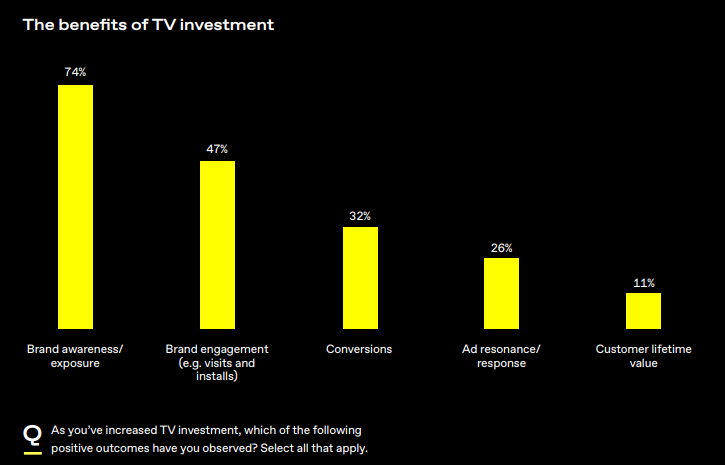
Just under half of respondents (47%) are seeing brand engagement, conversion (32%) and see TV as a sole contributing factor to driving site visits and purchase.
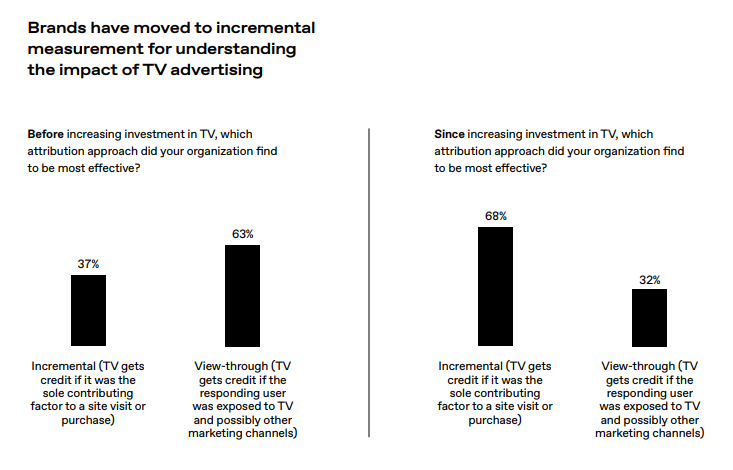
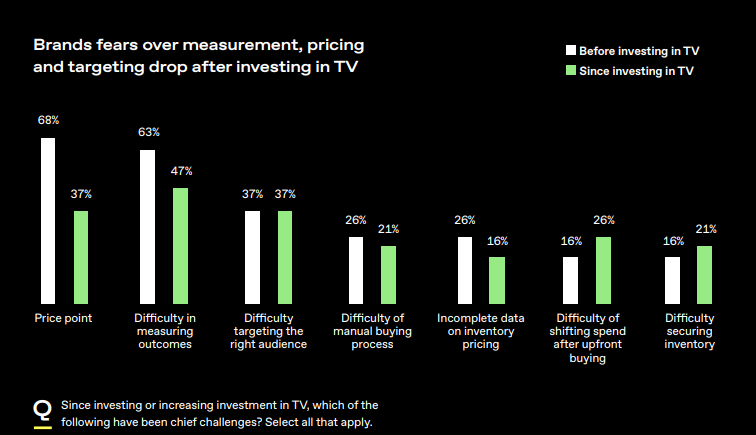
Digital hits a peak
Research shows that by and large advertisers say they’re already investing the right amount in standard digital video. But some might find it difficult to substantially increase ROI by increasing spend on available platforms and publisher sites. In effect, DTC brands may already be reaching a saturation point within social and digital video platforms, leading to diminishing returns — making TV a more appealing opportunity. For advertisers — especially smaller DTC advertisers — that are looking to expand or increase their investment in TV, it’s crucial to learn more about current inventory pricing and seek out partners that can help them master TV attribution and targeting.
To forge their path into the new future of TV, one shaped by radical changes to the ways advertisers understand pricing, inventory and access, brands must put misconceptions aside and start to view TV as a digital medium, where their best practices from digital still apply.



